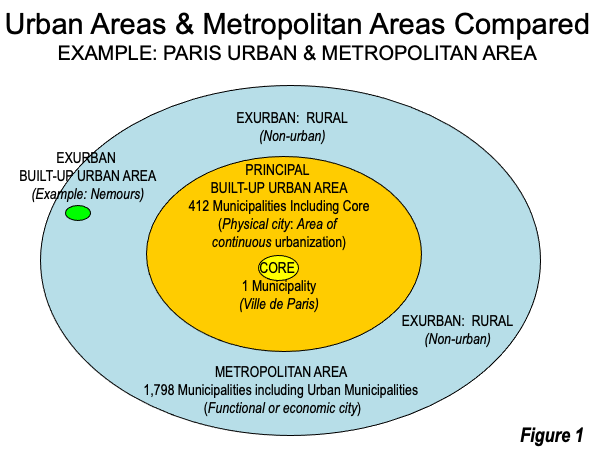The headline is from September 30, 2023's "Jakarta Closing Population Gap with Tokyo" which includes this graph:
....MUCH MORE
And the more recent New Geography article, December 18 Summary of World Urban Population by Nation and Region:
Defining "Built-Up Urban Area"
The term urban area refers to a continuously built landmass devoted to urban development. Unlike metropolitan areas, urban areas have no rural land within their boundaries. Similar definitions are used by national statistical authorities, such as in the United Kingdom (built up urban areas), Canada (population centres), the United States (urban areas) and Australia urban centres) and Scandinavian countries (urban areas).Urban areas constitute "urban footprints," illuminated cityscape visible at night from an airplane or satellite. This continuous urban area is within the surrounding metropolitan region, but the two have very different definitions. This article is a summary of urban populations and densities in the nearly 1,000 urban areas with 500,000 or more residents, using data from the 19th edition of Demographia World Urban Areas.
Internal Variations in Density
Population density data for urban areas often masks significant internal variations. Within the same urban area, densities can range drastically. For example, North American Urban areas typically exhibit lower densities, sometimes below 400 people per square kilometer, whereas informal settlements (slums) can reach over 1,000,000 per square kilometer, such as in Dhaka, Bangladesh.Comparing the Phoenix and Boston-Providence urban areas further illustrates this point in the American contest. It may seem surprising that Phoenix boasts a 60% higher average density than Boston-Providence. This is true even though the latter's highest density areas are at least five times as dense as those of Phoenix. Boston-Providence possesses a larger and denser central business district but its suburbs are far less dense than those in Phoenix. These internal variations are important to understanding the urban form. Despite its lower core densities in comparison to New York, Los Angeles' dense suburbs make it the most densely populated large urban area in the United States. This reflects the irony of the urban area most associated with "urban sprawl" factually being the least sprawling in the United States. Indeed, the San Jose urban area, nearly all of which is suburban, is denser than the New York urban area. Conversely, New York, despite much higher densities within the core, like the Boston area, sprawls over a larger area than any other urban area globally.
Similarly, London and Athens have comparable average densities, yet Athens boasts considerably higher core densities and much lower suburban densities. Likewise, the Essen-Dusseldorf and Milan Urban areas exhibit nearly identical overall densities, but Milan boasts a notably denser core.
The Difference Between Urban Areas and Metropolitan Areas
Urban areas are materially different from metropolitan areas, which are distinct entities. A metropolitan area represents a labor market (and coincidentally, a housing market), which includes the principal urban area, surrounding also economically connected rural areas and smaller urban areas outside the principal urban area.Urban areas draw commuters from labor markets that are larger geographically. For instance, the Paris urban area encompasses 2,845 square kilometers, while the Paris metropolitan area spans 17,100 square kilometers, indicating that over 80% of the land area lies outside the urban area itself.
Similarly, in the United States, only 19.7% of land within metropolitan areas exceeding 1 million is classified as urban, with the remaining 80.3% being rural. The Canadian context further underlines this distinction, with 87% of land classified as rural within census metropolitan areas.
Due to their fundamental differences, it is generally inappropriate to make comparisons between urban areas and metropolitan areas. Comparing urban areas and metropolitan areas is akin to comparing apples and oranges (Figure 1).

Urban Densities by Extent of Development
In 2023, approximately 2.3 billion lived in nearly 1,000 urban areas with more than 500,000, at an average population density of 4,200 per square kilometer. About 555 million people — one–quarter of the urban population — lives in 249 urban areas in more developed regions. Their average urban population density is 1,800 per square kilometer.The less developed regions include 1,752 million residents in 737 urban areas with more than 500,000 residents. The average population density of these urban areas is 7,100 per square kilometer. This is nearly four times the density in the urban areas of - more developed regions (Figure 2)....
....MUCH MORE
That difference in how you measure Paris' population is the reason for this note in 2018:
Between 1500 and 1900 Paris went from 8th largest city in the world with a population of around 185,000 to 3rd largest in the world with a population of, depending on how far out from the city center you measured, 2.7 to 3.6 million.
Back in the day those big cities were aromatic, see the first link below, if interested.
Looking at the graph above, none of the African megacities made the list. By 2100 they will dominate. If interested see "Megalopolis: how coastal west Africa will shape the coming century"
As the old-timers used to say, "Pay attention or pay the offer."
The estimated seven most populous cities in 2100 via the construction mavens at B1M:
1. LAGOS, NIGERIA - 88.3 MILLION
2. KINSHASA, DEMOCRATIC REPUBLIC OF THE CONGO - 83.5 MILLION
3. DAR ES SALAAM, TANZANIA - 73.7 MILLION
4. MUMBAI, INDIA - 67.2 MILLION
5. DELHI, INDIA - 57.3 MILLION
6. KHARTOUM, SUDAN – 56.6 MILLION
7. NIAMEY, NIGER – 56.1 MILLION
....MUCH MORE
None of the Chinese mega-cities makes the year 2100 top ten, nor does the current population champ, Tokyo.
Finally from a December 2019 post:
Did Kinshasa Just Pass Paris As the World's Most Populous French-Speaking City?
to page 23 we see population estimates of:
#27 Congo (Dem. Rep.) Kinshasa 12,960,000The whole thing is full of amazing stats (there are now 38 urban areas with populations over 10 million) but the Francophone tidbit (it's not highlighted in the report but you know they speak French in Kinshasa) kinda jumps out at one.
#33 France Paris 10,960,000